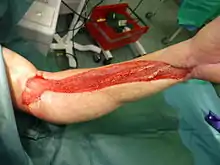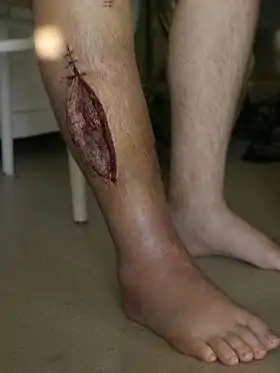Fasciotomy
Fasciotomy or fasciectomy is a surgical procedure where the fascia is cut to relieve tension or pressure commonly to treat the resulting loss of circulation to an area of tissue or muscle.[1] Fasciotomy is a limb-saving procedure when used to treat acute compartment syndrome. It is also sometimes used to treat chronic compartment stress syndrome. The procedure has a very high rate of success, with the most common problem being accidental damage to a nearby nerve.

| Fasciotomy | |
|---|---|
 When the pressure is down, the fasciotomy is covered with a skin graft. | |
| ICD-9 | 82.12 83.14 |
Indications
Compartment syndrome is one of the conditions where a fasciotomy may be indicated. People who are likely to have injuries needing a fasciotomy include the following:
- Crush injuries[2]
- Athletes who have sustained one or more serious impact injuries
- People with severe burns
- People who are severely overweight
- Snake bite victims, but very rarely
Complications
A delay in performing the procedure can lead to neurovascular complications or lead to the need for amputation of a limb.[1] Complications can also involve the formation of scar tissue after the operation. A thickening of the surgical scars can result in the loss of mobility of the joint involved. This can be addressed through occupational or physical therapy.
Process
.jpg.webp)
Fasciotomy in the limbs is usually performed by a surgeon under general or regional anesthesia. An incision is made in the skin, and a small area of fascia is removed where it will best relieve pressure.
Plantar fasciotomy is an endoscopic procedure. The physician makes two small incisions on either side of the heel. An endoscope is inserted in one incision to guide the physician. A tiny knife is inserted in the other. A portion of the fascia near the heel is removed. The incisions are then closed.
In addition to scar formation, there is a possibility that the surgeon may need to use a skin graft to close the wound. Sometimes when closing the fascia again in another surgical procedure, the muscle is still too large to close it completely. A small bulge is visible, but is not harmful. It takes a much longer time to heal and in some cases takes several months.
See also
References
- Dente CJ, Wyrzykowski AD, Feliciano DV (October 2009). "Fasciotomy". Current Problems in Surgery. 46 (10): 779–839. doi:10.1067/j.cpsurg.2009.04.006. PMID 19735797.
- "Compartment syndrome: MedlinePlus Medical Encyclopedia". Nlm.nih.gov. Retrieved 2014-03-08.